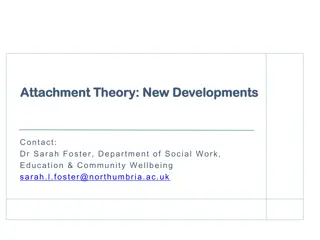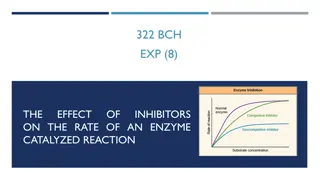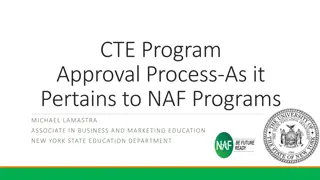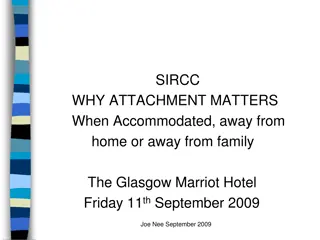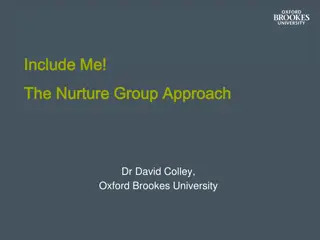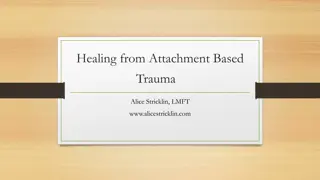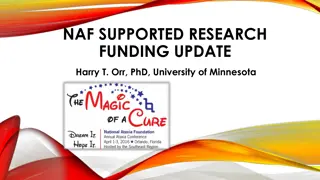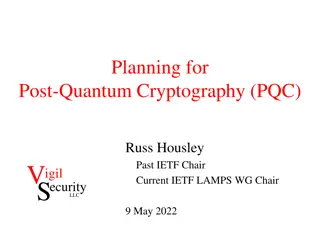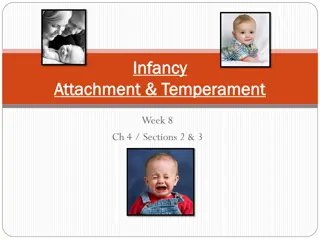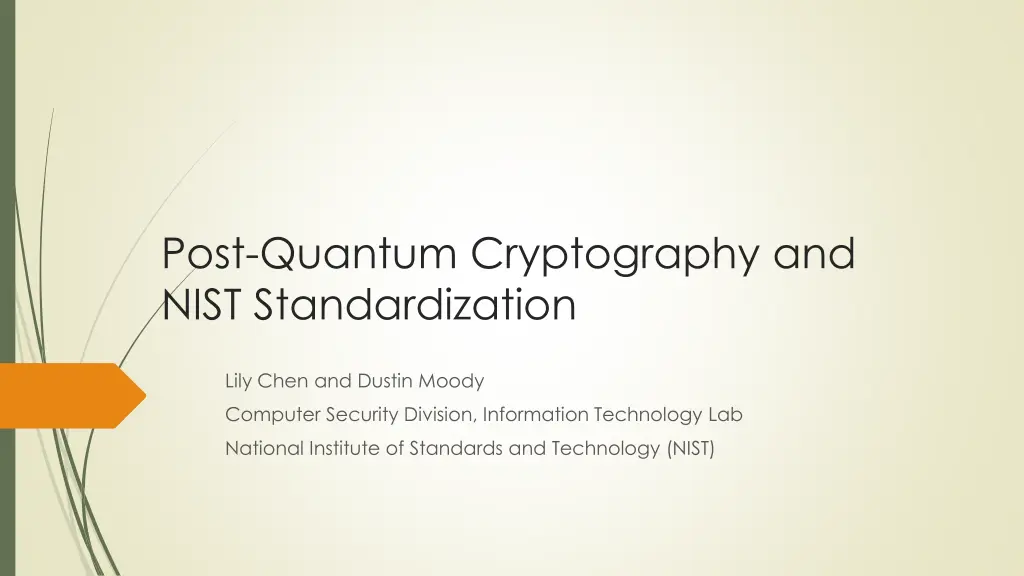
Post-Quantum Cryptography and NIST Standardization Overview
Learn about the impact of quantum computing on cryptography and NIST's efforts in developing post-quantum cryptography standards. Explore the journey NIST has taken, the PQC team's significant milestones, and their collaborations to address the need for quantum-resistant cryptosystems.
Download Presentation

Please find below an Image/Link to download the presentation.
The content on the website is provided AS IS for your information and personal use only. It may not be sold, licensed, or shared on other websites without obtaining consent from the author. If you encounter any issues during the download, it is possible that the publisher has removed the file from their server.
You are allowed to download the files provided on this website for personal or commercial use, subject to the condition that they are used lawfully. All files are the property of their respective owners.
The content on the website is provided AS IS for your information and personal use only. It may not be sold, licensed, or shared on other websites without obtaining consent from the author.
E N D
Presentation Transcript
Post-Quantum Cryptography and NIST Standardization Lily Chen and Dustin Moody Computer Security Division, Information Technology Lab National Institute of Standards and Technology (NIST)
Background Quantum computing changed what we have believed about the hardness of discrete log and factorization problems Using quantum computers, an integer n can be factored in polynomial time using Shor's algorithm The discrete logarithm problem can also be solved by Shor s algorithm in polynomial time As a result, the public key cryptosystems deployed since the 1980s will need to be replaced RSA signatures, DSA and ECDSA (FIPS 186-4) Diffie-Hellman Key Agreement over finite field and elliptic curves(NIST SP 800-56A) RSA encryption (NIST SP 800-56B) We are looking for quantum-resistant counterparts for these cryptosystems Quantum computing also impacted security strength of symmetric key based cryptography algorithms Grover s algorithm can find AES key with the work of 2?where n is the key length
What we have done so far The first mile in a long journey 2012 NIST begins PQC project Research and build NIST team April 2015 1stNIST PQC workshop Feb 2016 NIST Report on PQC (NISTIR 8105) Feb 2016 NIST preliminary announcement of standardization plan Aug 2016 Draft submission requirements and evaluation criteria released for public comments Sep 2016 Comment period ends Dec 2016 Announcement of finalized requirements and criteria(Federal Register Notice)
NIST PQC team The most significant in the first mile Consists of 10 NIST researchers in cryptography, quantum information, quantum algorithms Hold bi-weekly seminars (internal and invited speakers) Publish results at PQcrypto and other journals/conferences Engage with research community (presentations and discussion forums) Work with industry and standards organizations (ETSI, IETF, ISO/IEC SC27) Reach government agencies for raising awareness of upcoming cryptography transition Collaborate with QuiCS (Joint Center for Quantum Information and Computer Science), University of Maryland
Post-Quantum Cryptography- What has been in the standards and research? The main categories of PQC schemes Lattice based (e.g. NTRUencrypt, New Hope) Hash based signatures (e.g. XMSS and SPHINCS) Code based (e.g. McEliece) Multivariate (e.g. Rainbow) Other (e.g. isogenies on supersingular elliptic curves SIDH) Research has been rapidly advancing in the past five years Many schemes are proposed and analyzed Some are broken under classical attacks Industry has been moving towards quantum resistant cryptosystems Some standards organizations have considered specific schemes (e.g. IETF, hash- based signature) and some experts groups (e.g. EU PQcrypto) made recommendations
Post-Quantum Cryptography Standardization Is it too early? y x It has been a long debate among researchers and practitioners on whether it is too early to look into PQC standardization z A one-in-seven chance that some fundamental public-key crypto will be broken by quantum by 2026, and a one-in-two chance of the same by 2031 Michele Mosca If x+y > z, we should worry! y is the time taken for developing and deploying PQC standards The experience tells that we need at least years to developing and deploying PQC standards, i.e. y 10 x is the time for backward secrecy If we require 5-year backward secrecy, we certainly need to start standardization z is the time before quantum computers are available
Post-Quantum Cryptography Standardization A big decision to move forward Considering the time to develop/deploy PQC standards and the backward secrecy required for the information, it is the time to look into standardization NIST sees its role as managing a process of achieving community consensus in a transparent and timely manner NIST announced preliminary plan of developing PQC standards at PQCrypto 2016 The announcement received strong support from research community NIST released draft of call for proposals in August 2016 Scope public key signatures, encryption, key-exchange Basic requirements for each function Evaluation Criteria Security: security models, target security strengths classic and quantum Performance: key sizes, computational efficiency, and flexibility Plans for the Evaluation Process
PQC Standardization Plan Nov. 30, 2017 Submission deadline April 2018 Workshop Submitters presentations 3-5 years Analysis phase - NIST reports on findings and more workshops/conferences Draft standards available for public comments 2 years later NIST will post complete and proper submissions Narrowed pool will undergo a second round (12-18 months) Second conference to be held Minor changes allowed Possible third round of evaluation, if needed NIST will release reports on progress and selection rationale The actual duration for each stage may change NIST PQC Standardization Conference (with PQCrypto, Apr 2018) Initial phase of evaluation (12-18 months) Internal and public review No modifications allowed
The selection criteria Secure against both classical and quantum attacks Performance - measured on various "classical" platforms Other properties Drop-in replacements - Compatibility with existing protocols and networks Perfect forward secrecy Resistance to side-channel attacks Simplicity and flexibility Misuse resistance, and More
Complexities of PQC Standardization Much broader scope three crypto primitives Both classical and quantum attacks Both a theoretical and practical aspect to assess security Multiple tradeoff factors Migrations into new and existing applications Many challenges which we haven t dealt with in previous standards Not exactly a competition it is and it isn t
Security Notions Signatures Existentially unforgeable with respect to adaptive chosen message attack (EUF- CMA) Assume the attacker has access to no more than 264 signatures for chosen messages Encryption Semantically secure with respect to adaptive chosen ciphertext attack (IND-CCA2) Assume the attacker has access to no more than 264 decryptions for chosen ciphertexts These definitions specify security against attacks which use classical (not quantum) queries
Quantum Security How to assess the Strength? Currently, NIST cryptography standards specifies parameters for classical security levels at 112, 128, 192, 256 bits For PQC standardization, need to specify concrete parameters with security estimates Led to the bits of quantum security requirements in the draft CFP No clear consensus on best way to measure quantum attacks Uncertainties The possibility that new quantum algorithms will be discovered, leading to new attacks The performance characteristics of future quantum computers, such as their cost, speed and memory size
Quantum Security Strength Categories Security Description I At least as hard to break as AES128 (exhaustive key search) II At least as hard to break as SHA256 (collision search) III At least as hard to break as AES192 (exhaustive key search) IV At least as hard to break as SHA384 (collision search) V At least as hard to break as AES256 (exhaustive key search) Computational resources should be measured using a variety of metrics Number of classical elementary operations, quantum circuit size, etc Consider realistic limitations on circuit depth (e.g. 240 to 280 logical gates) May also consider expected relative cost of quantum and classical gates. These are understood to be preliminary estimates
Challenges Quantum security strength assessment is just one of the objectives, while the first and the foremost is the classical security Most of PQC schemes are relatively new It takes years to understand their classical security We need to deal with new situations which we haven t considered before, e.g. Decryption failure Public-key encryption and key-exchange issues Public-key encryption IND-CCA2 Ephemeral key exchange (no key-pair reuse, consider passive attacks, IND-CPA) Auxiliary functions/algorithms, e.g. Gaussian simulation We have to move away from many things we have been used with existing schemes
Cost and Performance Standardized post-quantum cryptography will be implemented in classical platforms Diversified applications require different properties from extremely processing constrained device to limited communication bandwidth May need to standardize more than one algorithm for each function to accommodate different application environments Allowing parallel implementation for improving efficiency is certainly a plus
Drop-in Replacements We re looking for Quantum resistant drop-in replacements for existing applications, e.g. Internet Key Exchange (IKE) and Transport Layer Security (TLS) Key establishment Ideally, we d like to have something to replace Diffie-Hellman key exchange Practically, we have to look into some schemes such as encryption with one-time public key, which are not quite drop-in replacements Signatures We d like to have signatures with reasonable public key size, signature size, and fast signature verification Practically, we shall prepare to handle probably larger public keys, or/and larger signatures We need to be realistic about what we can get for the quantum resistant counterpart for the existing applications
Transition and Migration NIST will update guidance when PQC standards are available SP 800-57 Part I specifies classical security strength levels 128, 192, and 256 bits are acceptable through 2030 Even with the upcoming PQC transition, still required to move away from weak algorithms/key sizes: Anything with classical security strength less than 112 bits should NOT be used anymore
Hybrid Mode Hybrid mode has been proposed as a transition/migration step towards PQC cryptography Key establishment by two schemes: A current approved schemes to obtain S1 and A post-quantum scheme to obtain S2 The keying material is derived from S1 and S2 Signature: message M is signed as Sig1(M) and Sig2(M) and the signature on M is valid if and only if Sig1(M) and Sig2(M) are both valid Sig1 () is a currently standardized algorithm, e.g. RSA, Sig2() is a PQC algorithm, e.g. XMSS. Current FIPS 140 validation will only validate the approved component The PQC standardization will only consider the post-quantum component
Interaction with Standards Organizations We are aware that many international/industry standards organizations and expert groups are working on or planning to work on post quantum cryptography standards/recommendations IETF is taking action in specifying stateful hash-based signatures ETSI released quantum-safe cryptography report EU expert groups PQCrypto and SafeCrypto made recommendations and released reports ISO/IEC JTC 1 SC27 has already had three six months study period for quantum-resistant cryptography NIST is interacting and collaborating with these organizations and groups NIST will standardize algorithms for general usage, not for specific applications NIST plan to consider hash-based signatures as an early candidates for standardization, but just for specific applications like code signing
Summary Post-quantum cryptography standardization is going to be a long journey After the first mile, we have observed many complexities and challenges NIST acknowledges all the feedback received, which has improved the submission requirements and evaluation criteria We will continue to work with the community towards PQC standardization See also: www.nist.gov/pqcrypto Sign up for the pqc-forum for announcements and discussion


